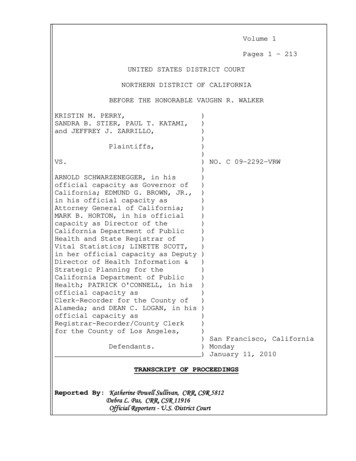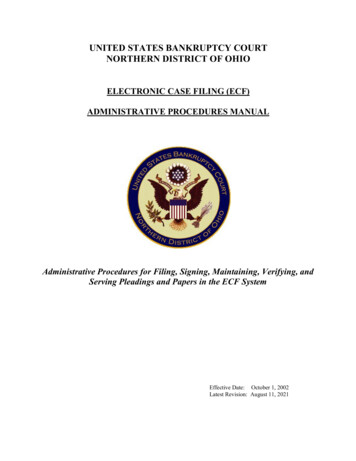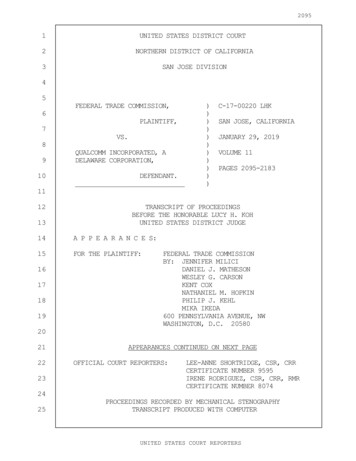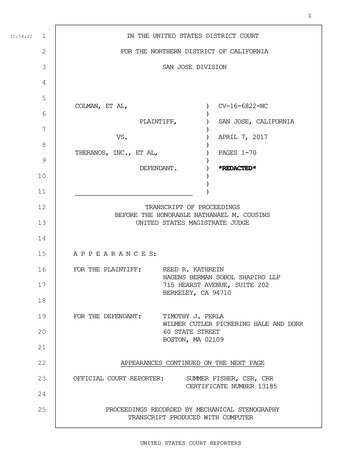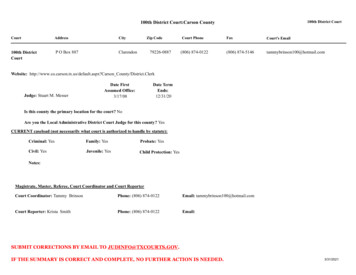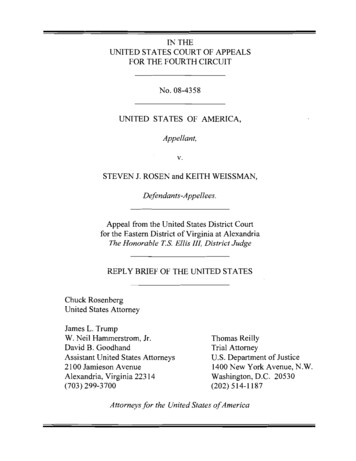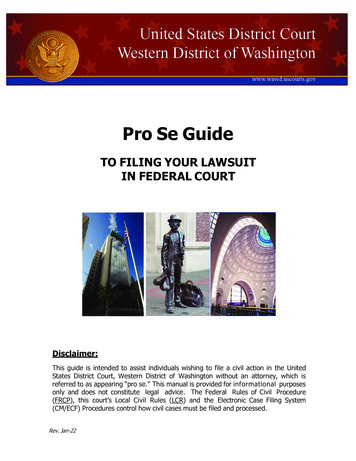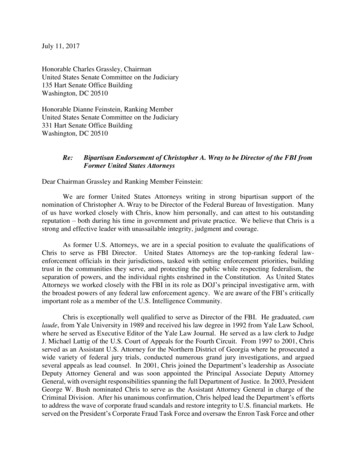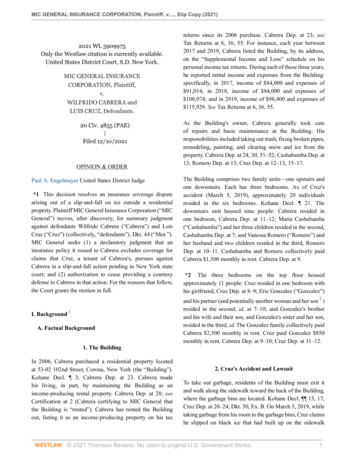
Transcription
MIC GENERAL INSURANCE CORPORATION, Plaintiff, v., Slip Copy (2021)2021 WL 5909975Only the Westlaw citation is currently available.United States District Court, S.D. New York.MIC GENERAL INSURANCECORPORATION, Plaintiff,v.WILFRIDO CABRERA andLUIS CRUZ, Defendants.20 Civ. 4855 (PAE) Filed 12/10/2021OPINION & ORDERPaul A. Engelmayer United States District Judge*1 This decision resolves an insurance coverage disputearising out of a slip-and-fall on ice outside a residentialproperty. Plaintiff MIC General Insurance Corporation (“MICGeneral”) moves, after discovery, for summary judgmentagainst defendants Wilfrido Cabrera (“Cabrera”) and LuisCruz (“Cruz”) (collectively, “defendants”). Dkt. 44 (“Mot.”).MIC General seeks (1) a declaratory judgment that aninsurance policy it issued to Cabrera excludes coverage forclaims that Cruz, a tenant of Cabrera's, pursues againstCabrera in a slip-and-fall action pending in New York statecourt; and (2) authorization to cease providing a courtesydefense to Cabrera in that action. For the reasons that follow,the Court grants the motion in full.I. Background 1A. Factual Background1. The BuildingIn 2006, Cabrera purchased a residential property locatedat 53-02 102nd Street, Corona, New York (the “Building”).Kohane Decl. ¶ 3; Cabrera Dep. at 23. Cabrera madehis living, in part, by maintaining the Building as anincome-producing rental property. Cabrera Dep. at 28; seeCertification at 2 (Cabrera certifying to MIC General thatthe Building is “rented”). Cabrera has rented the Buildingout, listing it as an income-producing property on his taxreturns since its 2006 purchase. Cabrera Dep. at 23; seeTax Returns at 6, 36, 55. For instance, each year between2017 and 2019, Cabrera listed the Building, by its address,on the “Supplemental Income and Loss” schedule on hispersonal income tax returns. During each of those three years,he reported rental income and expenses from the Building:specifically, in 2017, income of 84,000 and expenses of 91,014; in 2018, income of 84,000 and expenses of 108,074; and in 2019, income of 98,400 and expenses of 115,929. See Tax Returns at 6, 36, 55.As the Building's owner, Cabrera generally took careof repairs and basic maintenance at the Building. Hisresponsibilities included taking out trash, fixing broken pipes,remodeling, painting, and clearing snow and ice from theproperty. Cabrera Dep. at 24, 30, 51–52; Cashabamba Dep. at13; Romero Dep. at 13; Cruz Dep. at 12–13, 15–17.The Building comprises two family units—one upstairs andone downstairs. Each has three bedrooms. As of Cruz'saccident (March 5, 2019), approximately 20 individualsresided in the six bedrooms. Kohane Decl. ¶ 21. Thedownstairs unit housed nine people: Cabrera resided inone bedroom, Cabrera Dep. at 11–12; Maria Cashabamba(“Cashabamba”) and her three children resided in the second,Cashabamba Dep. at 7; and Vanessa Romero (“Romero”) andher husband and two children resided in the third, RomeroDep. at 10–11. Cashabamba and Romero collectively paidCabrera 1,500 monthly in rent. Cabrera Dep. at 9.*2 The three bedrooms on the top floor housedapproximately 11 people: Cruz resided in one bedroom withhis girlfriend, Cruz Dep. at 8–9; Eric Gonzalez (“Gonzalez”)and his partner (and potentially another woman and her son 2 )resided in the second, id. at 7–10; and Gonzalez's brotherand his wife and their son, and Gonzalez's sister and her son,resided in the third, id. The Gonzalez family collectively paidCabrera 2,500 monthly in rent. Cruz paid Gonzalez 850monthly in rent. Cabrera Dep. at 9–10; Cruz Dep. at 11–12.2. Cruz's Accident and LawsuitTo take out garbage, residents of the Building must exit itand walk along the sidewalk toward the back of the Building,where the garbage bins are located. Kohane Decl. ¶¶ 15, 17;Cruz Dep. at 20–24; Dkt. 50, Ex. B. On March 5, 2019, whiletaking garbage from his room to the garbage bins, Cruz claimshe slipped on black ice that had built up on the sidewalk 2021 Thomson Reuters. No claim to original U.S. Government Works.1
MIC GENERAL INSURANCE CORPORATION, Plaintiff, v., Slip Copy (2021)abutting the Building. Kohane Decl. ¶ 3; Cruz Dep. at 20–21.The accident occurred on the sidewalk located at the corner ofthe Building. Cruz Dep. at 20. As Cruz described the accident,he “went down the stairs and . walked towards the containersof the garbage,” when he “slipped with that black ice that wasthere” and “broke [his] leg.” Id. at 21.On December 26, 2019, Cruz brought a negligence actionagainst Cabrera in New York State Court in Queens County.Cruz alleged that Cabrera had negligently failed to removethe ice, in violation of his alleged duty to safely maintain thepremises (the “Underlying Action”). Kohane Decl. ¶¶ 3, 6,Ex. D. That action is pending.(a) on an occasional basis if used only as a residence;(b) in part for use only as a residence, unless a singlefamily unit is intended for use by the occupying familyto lodge more than two roomers or boarders; or(c) in part, as an office, school, studio or private garage.Id. at 72. For purposes of the instant motion, it is undisputedthat Cabrera is the “insured” and that the Building is the“Insured location.” 34. MIC General's Disclaimer and Courtesy Defense3. The Insurance PolicyMIC General had issued a homeowner's insurance policy toCabrera for the Building, effective, as relevant here, fromFebruary 22, 2019 to February 22, 2020. Kohane Decl. ¶7; see generally Policy. Relevant here are two exclusions inthe Policy: a “Business Pursuits Exclusion” and a “RentalExclusion.”The “Business Pursuits Exclusion” excludes from coverageliability for a bodily injury:arising out of or in connectionwith a “business” engaged in byan “insured.” This exclusion appliesbut is not limited to an act oromission, regardless of its nature orcircumstances, involving a service orduly [sic] rendered, promised, owed orimplied to be provided because of thenature of the “business.”Policy at 72. “Business” is defined to mean “trade, professionor occupation.” Id. at 71.The “Rental Exclusion” excludes from coverage liability fora bodily injury:(1) arising out of the rental or holding for rental of any partof any premises by an “insured.” This exclusion does notapply to the rental or holding for rental of an “insuredlocation:”*3 On January 31, 2020, Cabrera tendered the UnderlyingAction to MIC General. Kohane Decl. ¶ 9. On February 6,2020, after investigating, MIC General issued a Disclaimer toCabrera stating that, for multiple reasons, the Policy did notcover him in connection with Cruz's lawsuit. Relevant here,the Disclaimer stated that the Business Pursuits Exclusionand Rental Exclusion each applied because Cruz's injuries,as alleged, “arose out of or [were] in connection with”Cabrera's business and/or his “rental or holding for rental”part of the Building. See Disclaimer at 5–6. Nonetheless, MICGeneral agreed to provide a courtesy defense to Cabrera inthe Underlying Action until a court had held its Disclaimervalid. Id. at 2, 6; Kohane Decl. ¶ 12.B. Procedural Background of This ActionOn June 24, 2020, MIC General filed the Complaint. Itsought a declaratory judgment that under the Policy, MICGeneral is not obligated to defend or indemnify Cabrerain the Underlying Action and that MIC General may ceaseproviding Cabrera a defense. Dkt. 1. As of August 19, 2020,neither defendant had answered; MIC General thus moved fora default judgment against Cabrera and Cruz. Dkt. 13. Thatsame day, Cabrera answered. Dkt. 18. On August 20, 2020,in light of Cabrera's answer and the Court's preference forresolving lawsuits on the merits, the Court sua sponte deniedthe motion for default judgment against Cabrera. Dkt. 20.On August 24, 2020, Cruz filed an answer. Dkt. 23. On August31, 2020, in response to a Court order, counsel for Cruzfiled an affidavit explaining that he had signed a stipulationwith MIC General extending the time to answer or otherwiseappear to August 24, 2020. Dkt. 26. On September 2, 2020,in light of the stipulation, the Court denied the motion for 2021 Thomson Reuters. No claim to original U.S. Government Works.2
MIC GENERAL INSURANCE CORPORATION, Plaintiff, v., Slip Copy (2021)default judgment against Cruz. Dkt. 27. The case proceededto discovery.On May 11, 2021, after the close of fact discovery, MICGeneral filed the instant motion for summary judgment. Dkt.44. On June 4 and 5, 2021, Cabrera and Cruz, respectively,filed oppositions. Dkts. 49, 51. On June 15, 2021, MICGeneral filed a reply. Dkt. 54.II. Legal StandardsA. Motion for Summary JudgmentTo prevail on a motion for summary judgment, the movantmust “show[ ] that there is no genuine dispute as to anymaterial fact and the movant is entitled to judgment as amatter of law.” Fed. R. Civ. P. 56(a); seeCelotex Corp. v.Catrett, 477 U.S. 317, 322–23 (1986). The movant bears theburden of demonstrating the absence of a question of materialfact. In making this determination, the Court must view allfacts “in the light most favorable” to the non-moving party.Holcomb v. Iona Coll., 521 F.3d 130, 132 (2d Cir. 2008).If the movant meets its burden, “the nonmoving party mustcome forward with admissible evidence sufficient to raisea genuine issue of fact for trial in order to avoid summaryjudgment.” Jaramillo v. Weyerhaeuser Co., 536 F.3d 140, 145(2d Cir. 2008). “[A] party may not rely on mere speculationor conjecture as to the true nature of the facts to overcomea motion for summary judgment.”Hicks v. Baines, 593F.3d 159, 166 (2d Cir. 2010) (citation omitted). Rather, tosurvive a summary judgment motion, the opposing party mustestablish a genuine issue of fact by “citing to particular partsof materials in the record.” Fed. R. Civ. P. 56(c)(1)(A); seealsoWright v. Goord, 554 F.3d 255, 266 (2d Cir. 2009).“Only disputes over facts that might affect the outcomeof the suit under the governing law” will preclude a grantof summary judgment.Anderson v. Liberty Lobby, Inc.,477 U.S. 242, 248 (1986). In determining whether there aregenuine issues of material fact, a court is “required to resolveall ambiguities and draw all permissible factual inferencesin favor of the party against whom summary judgment issought.”Johnson v. Killian, 680 F.3d 234, 236 (2d Cir.2012) (quotingCir. 2003)).Terry v. Ashcroft, 336 F.3d 128, 137 (2dB. Insurers’ Duties to Defend and Indemnify*4 Under New York law, an “insurer's duty to defend itsinsured arises whenever the allegations in a complaint statea cause of action that gives rise to the reasonable possibilityof recovery under the policy.” Stein v. N. Assur. Co. ofAm., 617 F. App'x 28, 30 (2d Cir. 2015) (summary order)(quoting Town of Massena v. Healthcare Underwriters Mut.Ins. Co., 779 N.E.2d 167, 170 (N.Y. 2002)). Accordingly,the insurer's “duty to defend is broader than its duty toindemnify.” Auto. Ins. Co. of Hartford v. Cook, 850 N.E.2d1152, 1155 (N.Y. 2006). This places a “heavy burden” on theinsurer, which “may only disclaim its duty to defend if it hasdemonstrated, as a matter of law, that there is no possiblefactual or legal basis upon which the insurer may eventuallybe held obligated to indemnify the insured under any policyprovision.” Stein, 617 F. App'x at 30 (cleaned up).Whether the insurer has a duty to defend the insured is“ordinarily ascertained by comparing the allegations of acomplaint with the wording of the insurance contract.” Int'lBus. Machs. Corp. v. Liberty Mut. Ins. Co., 363 F.3d 137, 144(2d Cir. 2004); see also Swan Consultants Inc. v. TravelersProp. Cas. Co., 360 F. Supp. 2d 582, 588 (S.D.N.Y. 2005)(“[If] the factual allegations of the underlying complaintindicate that there is ‘no basis for recovery within thecoverage of the policy ., [a court] may sustain [the insurancecompany's] refusal to defend.’ ” (quotingAllstate Ins. Co.v. Mugavero, 589 N.E.2d 365, 370 (N.Y. 1992)) (internalquotation omitted)). “[W]here an insurer's duty to defendturns on an unresolved factual dispute, the duty to defend lastsonly until the factual ambiguity is resolved in favor of theinsurer.” Stein, 617 F. App'x at 30–31 (cleaned obligations . are not ripe for adjudication until liability hasbeen imposed upon the party to be indemnified.”FSP,Inc. v. Societe Generale, No. 02 Civ. 4786 (GBD), 2003WL 124515, at *4 (S.D.N.Y. Jan. 14, 2003), aff'd andremanded, 350 F.3d 27 (2d Cir. 2003), and adhered to onreconsideration,2005 WL 475986 (S.D.N.Y. Feb. 28,2005); see alsoAtl. Cas. Ins. Co. v. Value Waterproofing,Inc., 918 F. Supp. 2d 243, 261 (S.D.N.Y. 2013) (“Courtsoften distinguish between the duty to defend and the dutyto indemnify in determining whether each issue posed in adeclaratory judgment action is ripe for adjudication” because“the duty to defend is triggered by the filing of a lawsuit 2021 Thomson Reuters. No claim to original U.S. Government Works.3
MIC GENERAL INSURANCE CORPORATION, Plaintiff, v., Slip Copy (2021)while the duty to indemnify is triggered by a determinationof liability.”), aff'd sub nom. Atl. Cas. Ins. Co. v. GreenwichIns. Co., 548 F. App'x 716 (2d Cir. 2013) (summary order).However, “a decision on the duty to defend will sometimesproduce a definite answer with respect to the duty toindemnify as well,” in which case the indemnity claim is ripefor adjudication.Value Waterproofing, Inc., 918 F. Supp.2d at 261. In particular, “to the extent that the questions aboutinsurance coverage which arise in the declaratory judgmentaction can be separated from the issues of liability andcausation that are being litigated in the underlying lawsuit,there is far less reason to withhold judgment on the questionof indemnification.” Id.III. DiscussionWhether MIC General is obligated to defend Cabrera turnson whether the Policy covers Cruz's type of injury. See UnionMut. Fire Ins. Co. v. Tejada, No. 20 Civ. 9166 (PAE), 2021WL 3146032, at *3 (S.D.N.Y. July 23, 2021). Importantly,MIC General's assertion that it is not so obligated doesnot turn on the merits of Cruz's negligence claims in theUnderlying Action. Rather, based on two exclusions in thePolicy arising from Cabrera's rental of apartments withinthe Building, including to Cruz, MIC General “seeks adeclaration that it does not have to defend or indemnify [him]because the policy excludes [Cruz]’s type of injury,” Id. Asthere has been full discovery with respect to those exclusions,MIC General's claims as to its duty both to indemnify anddefend are both ripe for adjudication.A. The Business Pursuits Exclusion*5 The Business Pursuits Exclusion excludes from coverageliability for a bodily injury “arising out of or in connectionwith” a “business” engaged in by an insured. Policy at 72. Theexclusion applies to acts or omissions “involving a service ordu[t]y rendered, promised, owed or implied to be providedbecause of the nature of the ‘business.’ ” Id.Thus, if the Underlying Action alleges that Cabrera owedCruz a duty to maintain the sidewalk in a reasonably safecondition “because of the nature of the ‘business,’ ” andif Cruz's injury as alleged arose out of Cabrera's failure todo so, then the exclusion would apply. For the Court to sofind and grant summary judgment to MIC General on thispoint, the evidence must establish three propositions: that(1) Cabrera ran the Building as a “business”; (2) Cabreraowed Cruz a duty to keep the sidewalk reasonably safe fortenants to traverse to the garbage area which arose from “thenature of the ‘business’ ”; and (3) Cruz's injury arose “inconnection with” Cabrera's failure to carry out that duty. Inmaking these assessments as to the availability of coverage,the Court, to the extent drawing upon the Underlying Action,“look[s] to ‘the factual allegations of the complaint, and notits legal characterizations of the underlying events.’ ” SwanConsultants, 360 F. Supp. 2d at 588 (quotingDodge v.Legion Ins. Co., 102 F. Supp. 2d 144, 150 (S.D.N.Y. 2000));see also Middlesex Ins. Co. v. Mara, 699 F. Supp. 2d 439, 449n.12 (D. Conn. 2010) (“The key is what the plaintiffs in theunderlying action might be able to prove, not will prove.”).1. Did Cabrera Run the Building as a “Business”?The Policy defines “business” as a “trade, profession oroccupation,” Policy at 71, but it does not define those terms.Under New York law, whether an activity is a business pursuitwithin the meaning of an insurance policy's business pursuitsexclusion depends on whether the insured “regularly engagedin a particular activity with a view toward earning a livelihoodor making a profit. To constitute a business, there must be twoelements: “first, continuity, and secondly, the profit motive.”Showier v. Am. Mfrs. Mut. Ins. Co., 690 N.Y.S.2d 369, 369(N.Y. App. Div. 1999) (quoting Broome County Co-Op. FireIns. Co. v. Kendall, 576 N.Y.S.2d 945, 945 (N.Y. App. Div.1991)) (emphasis in original); see alsoAm. Family HomeIns. Co. v. Delia, No. 12 Civ. 5380 (ADS), 2013 WL 6061937,at *5 (E.D.N.Y. Nov. 15, 2013). As to continuity, there must bea “a customary engagement or a stated occupation.” Faddenv. Cambridge Mut. Fire Ins. Co., 274 N.Y.S.2d 235, 241 (N.Y.Sup. Ct. 1966), aff'd,280 N.Y.S.2d 209 (N.Y. App. Div.1967); see also Cardinal v. Long Island Power Auth., 309F. Supp. 2d 376, 392 (E.D.N.Y. 2004). As to profit motive,“there must be shown to be such activity as a means oflivelihood, gainful employment, means of earning a living,procuring subsistence or profit, commercial transactions orengagements.” Fadden, 274 N.Y.S.2d at 241.Cabrera's long-term management of the Building easilysatisfies the continuity element. See Cardinal, 309 F. Supp.2d at 392 (continuity element satisfied where real estateagent had been charged with management and maintenanceof property for 14 years). By his own account, every yearsince 2006, he has owned and rented out the Building, andfor years he has written off on his taxes business expensesincurred in connection with the Building. See Cabrera Dep. 2021 Thomson Reuters. No claim to original U.S. Government Works.4
MIC GENERAL INSURANCE CORPORATION, Plaintiff, v., Slip Copy (2021)at 23 (“Q: Did you take business deductions for the – foryour repair work at [the Building]? A: Yes. Q: Did you reportthe rent as business income? A: I declared what I receivedfor rent[.] Q: Sir, how long have you declared [the Building]as a business property? A: Since the date I bought.”); seealso Tax Returns at 6, 36, 55; Certification at 2. Cabrera alsoperforms a wide range of maintenance and upkeep on theBuilding, including sometimes on his own initiative. Suchwork includes remodeling and various projects to keep theBuilding in good order. See Cabrera Dep. at 24–25, 30, 51–52.*6 The profit motive element is also satisfied. Cabreradoes not dispute that he ran the Building to make money.And, in his Certification in connection with applying forthe Policy, he signed alongside handwriting, in Spanish,stating that the houses “are rented.” See Certification at28–29; see also Cardinal, 309 F. Supp. 2d at 392 (findingprofit motive satisfied in insurance coverage case based inpart on deposition testimony that the insured “cleaned up,straightened up, d[id] whatever [had] to be done” aroundthe property, and performed work in preparation for aprospective tenant seeking to rent). Cabrera's profit motiveis further confirmed by his tax returns, whose scheduleof “Supplemental Income Sources” lists substantial incomederived from the Building, and which reflects substantialtax deductions for expenses incurred in connection with theBuilding. Tax Returns at 6, 36, 55. Cabrera also took outadvertisements to rent out rooms in the Building and executedleases with some residents. See Cabrera Dep. at 8, 42.Cabrera argues that he did not run the Building as a “business”because he and his wife, who jointly file their taxes, havesources of income other than rental income from the Building.Dkt. 49 (“Cabrera Opp'n”) at 12. That argument fails. ThatCabrera has additional income sources does not negate thefact that he ran the Building “as a means of livelihood, gainfulemployment, [or] means or earning a living.” Fadden, 274N.Y.S.2d at 241. It merely suggests that Cabrera had multiplemeans of earning a living.The Court accordingly finds that Cabrera ran the Building asa “business.”2. Did Cabrera Owe Cruz a Duty, Arisingfrom the Nature of the Business, toKeep the Sidewalk Reasonably Safe?It is undisputed that Cabrera owed a duty to keep the sidewalkabutting the Building reasonably safe. See Cabrera Opp'nat 13; Dkt. 51 (“Cruz Opp'n”) at 8. The dispute as to thiselement concerns the source of that duty. Defendants arguethat Cabrera had a statutory duty to this effect, “irrespectiveof whether his property is considered a business.” CabreraOpp'n at 13; see N.Y.C. Admin. Code § 7-210. Put in Policyterms, defendants appear to argue that Cabrera's duty to keepthe sidewalk reasonably safe arose was statutory, based on hisbeing a New York City property owner, and did not arise fromhis role as a landlord. MIC General counters that the statutedefendants cite does not apply to the Building, and that, in anyevent, New York common law governing the landlord-tenantrelationship imposed on Cabrera the duty at issue.MIC General is again correct. At the outset, the decisiveissue is whether Cabrera owed Cruz a duty to keep thesidewalk safe in his capacity as a landlord. Even if Cabrerahad the same duty in other capacities (e.g., as a propertyowner), the Exclusion by its terms is not limited to thecircumstance where the duty arose exclusively from thepolicy holder's business capacity. Here, there could havebeen multiple sources of Cabrera's duty to keep the sidewalkreasonably safe. Cf. Bryndle v. Boulevard Towers, II, LLC,132 F. Supp. 3d 486, 500 (W.D.N.Y. 2015) (as to duty toconduct reasonable inspections, insured may have both astatutory duty to do so as a property owner under the NewYork City Administrative Code and a common law duty todo so as a landlord). But under the text of the Policy, so longas one such source was “the nature of the ‘business,’ ” thiselement of the Exclusion is met. See Policy at 72.Here, under New York law, Cabrera, by virtue of renting outthe Building for profit, owed his tenants the duty on whosebreach Cruz's lawsuit (which faults Cabrera for failing toremove the ice on the pathway to garbage disposal area) turns:to keep common areas such as sidewalks reasonably safe.See, e.g., Bryndle, 132 F. Supp. 3d at 500 (citingWynnv. T.R.I.P. Redev. Assoc., 745 N.Y.S.2d 97, 100 (N.Y. App.Div. 2002) (“Under long-standing common law, a landlordhas a duty to use ordinary care to keep those areas which arereserved and intended for the common use of the tenants andowner of the building and subject to the landlord's control,i.e., the common areas, ‘in a reasonably safe and suitablecondition.’ ”));Wynn, 745 NY.S.2d at 100–01 (citingcases); Fitje v. United States, No. 11 Civ. 1604 (MKB), 2016WL 1273236, at *6 (E.D.N.Y. Mar. 31, 2016) (same); seealsoAntoine v. City of New York, 868 N.Y.S.2d 688, 691 2021 Thomson Reuters. No claim to original U.S. Government Works.5
MIC GENERAL INSURANCE CORPORATION, Plaintiff, v., Slip Copy (2021)(N.Y. App. Div. 2008) (“[U]nder New York law, the coverageafforded by a premises liability policy extends by implicationto that portion of an outside sidewalk necessary for accessto the covered premises.” (citingZKZ Assocs. LP v.CNA Ins. Co., 679 N.E.2d 629 (N.Y. 1997)));Ambrosiov. Newburgh Enlarged City Sch. Dist., 774 N.Y.S.2d 153,155 (N.Y. App. Div. 2004) (“Although the sidewalk wherethe injured plaintiff fell was not specifically named in theendorsement as leased premises, its use was incidental tothe covered premises.”). These precedents underscore thatCabrera had this duty “because of” the nature of his business(as a landlord). Defendants do not argue that these casescan be read otherwise. The existence of such a duty on alandlord's part thus resolves this element of the BusinessPursuits Exclusion.*7 In any event, to the extent defendants wrongly positthat the existence of an alternative source of such a dutywould defeat the Business Pursuits Exclusion, their analysisof the duty under New York City Administrative Code §7-210 to keep a sidewalk reasonably safe is errant. Section7-210 states, in relevant part: “It shall be the duty of theowner of real property abutting any sidewalk, including, butnot limited to, the intersection quadrant for corner property,to maintain such sidewalk in a reasonably safe condition.”N.Y.C. Admin. Code § 7-210(a). Under it, a property owner's“failure to remove snow, ice, dirt or other material from thesidewalk” exposes her to tort liability. Id. § 7-210(b); seeLopez v. United States, No. 10 Civ. 1758 (DF), 2012 WL983560, at *8 (S.D.N.Y. Mar. 23, 2012) (“Section 7-210requires owners of real property abutting any ‘sidewalk’ tomaintain that sidewalk in a reasonably safe condition, andit provides for liability where the failure to fulfill this dutyproximately causes personal injury.”).Defendants depict this ordinance as applicable to all buildingowners. But that is incorrect. The ordinance “expresslyexcludes certain owner-occupied properties from its reach.”Xiang Fu He v. Troon Mgmt., Inc., 137 N.E.3d 469, 473(N.Y. 2019); see also Vucetovic v. Epsom Downs, Inc., 890N.E.2d 191, 194 n.3 (N.Y. 2008), It states that it “shall notapply to one-, two- or three-family residential real propertythat is (i) in whole or in part, owner occupied, and (ii) usedexclusively for residential purposes.” N.Y.C. Admin. Code §7-210(b). To be sure, that exception does not apply in thiscase, because Cabrera did not use the Building “exclusivelyfor residential purposes”; rather, as shown, he also used itfor the business purpose of obtaining rental income. Butthat reinforces that the Policy's Business Pursuits Exclusionapplies in this case. That is because § 7-210(b)—whichimposed on Cabrera the duty to keep the sidewalk reasonablysafe—applies precisely because Cabrera ran the Building asa business. Put differently, the statutory duty, like the similarcommon law duty, applies, in the language of the Exclusion,“because of the nature of the ‘business.’ ” 4In sum, whether Cabrera's duty to keep the sidewalkreasonably safe flowed from common law, a city statute, orboth, it was “owed or implied to be provided because of thenature of the ‘business.’ ” Policy at 72. This second elementof the Exclusion is also established.3. Does the Underlying Action Allege that Cruz'sInjury Arose Out of Cabrera's Failure to Maintainthe Sidewalk in a Reasonably Safe Condition?*8 The final issue is whether Cruz's injury “ar[ose] out of”or was “in connection with” Cabrera's failure to maintainthe sidewalk in a reasonably safe condition (the allegedlyomitted duty). “The ‘arising out of language, when usedin an insurance policy exclusion, is construed as a but-fortest.” Swan Consultants, 360 F. Supp. 2d at 59; see alsoOutwater v. Ballister, 678 N.Y.S.2d 396, 399 (N.Y. App.Div. 1998) (“[I]f the injury was caused by an act that wouldnot have occurred but for the business pursuits of the insured,said act is beyond the scope of the policy.”). The SecondCircuit, synthesizing New York case law, has further heldthat “[a]n insured is engaging in a business pursuit whenhis activities are ‘incidental to his employment.’ ” Bowmanv. Allstate Ins. Co., 238 F.3d 468, 470 (2d Cir. 2001) (percuriam) (quotingSalimbene v. Merchants Mut. Ins. Co.,629 N.Y.S.2d 913, 915 (N.Y. App. Div. 1995)) (citing cases).Here, Cruz's Underlying Action alleges that but for Cabrera'snegligent maintenance of the sidewalk, to wit, Cabrera'sfailure to clear ice from the sidewalk, Cruz would not havebeen injured. Cruz's Action pleads that Cabrera owned,operated, managed, controlled, and maintained the sidewalkabutting the Building, Dkt. 45-4 ¶¶ 15–19; that Cabrera had aduty to exercise reasonable care in his ownership and controlof that sidewalk so as to keep it safe, id. ¶¶ 20–22; that henegligently failed to do so, leaving it in a dangerous anddefective condition, id. ¶¶ 24–28; and that that conditioncaused Cruz to slip and fall and be injured, id. ¶¶ 23, 29. Theseallegations clearly convey that Cruz's injury “ar[ose] out of 2021 Thomson Reuters. No claim to original U.S. Government Works.6
MIC GENERAL INSURANCE CORPORATION, Plaintiff, v., Slip Copy (2021)or [was] in connection with” his asserted breach of the dutyat issue.The Business Pursuits Exclusion thus unambiguously applies,as the Underlying Action alleges that plaintiff Cruz's injuryarose out of defendant Cabrera's breach of his duty to maintainthe sidewalk abutting the Building in a reasonably safecondition—a duty Cabrera owed by virtue of having runthe Building as a business. The Court therefore grants MICGeneral summary judgment on the basis that the BusinessPursuits Exception applies. 5B. The Rental ExclusionThe Rental Exclusion excludes from coverage bodily injury“arising out of the rental or holding for rental of any partof any premises.” Policy at 72. But the exclusion containsan exception—which in turns embeds another exception.Specifically, the exclusion does not apply if the Building were“in part for use only as a residence, unless a single family unitis intended for use by the occupying family to lodge more thantwo roomers or boarders.” Id. (emphasis added). The Court'sanalysis reviews this nest of provisions layer by layer.*9 The parties do not dispute that Cruz's injury arose outof the rental. It clearly did, in that, but for his tenancy, Cruzwould not have slipped on the sidewalk abutting the Buildingwhile taking out the garbage. The parties also do not disputethat the Building was “in part for use only as a residence.”That too is clearly correct, in that Cabrera, along with histenants, lived there.The question, then, is whether the “unless” clause is triggered.If not, then the exception to the Rental Exclusion applies (andCabrera wins on this point); if so, then the Rental Ex
3. The Insurance Policy MIC General had issued a homeowner's insurance policy to Cabrera for the Building, effective, as relevant here, from February 22, 2019 to February 22, 2020. Kohane Decl. ¶ 7; see generally Policy. Relevant here are two exclusions in the Policy: a "Business Pursuits Exclusion" and a "Rental Exclusion."
